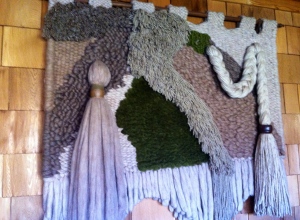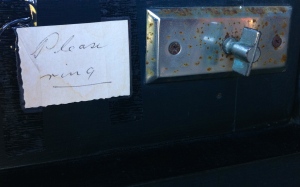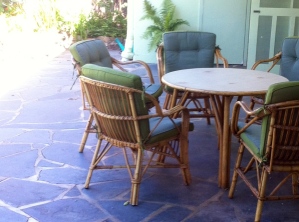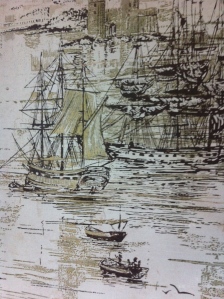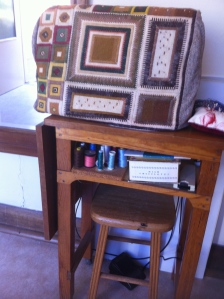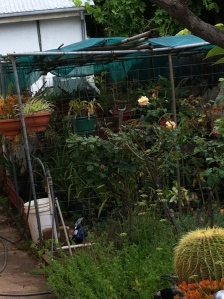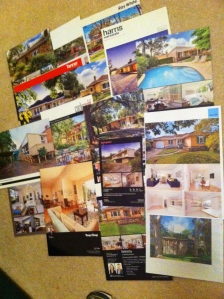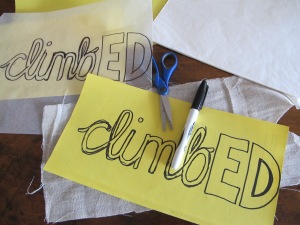We did it. Bought our first real grown-up house.
One we can afford (just), one that will fit us all comfortably and with a long-term view (the average length of time people in Australia inhabit a home is 9 years. Happily, we will be in ours for more than that).
In May this year we bid $1000 more than the other bidder (a developer). Between the two of us, it was a swift auction. Essentially, our opponent was purchasing the property for its land value only. We felt excited that we’d saved a piece of Adelaide architectural history, and one which we could renovate sustainably – so much so we even tried to bid against ourselves at one stage !
The house was ideal – a large block, 4 bedroom layout, great orientation, bare bones needing a little revamp. An unusual design, something unique.

This property started life as an idea for a newly-married couple by the name of Treloar in 1952. Their initial plan was a small home “overlooking Adelaide and the Gulf” with folding walls “to create one large reception room when required”. Other features like a woodbox – which could be filled from the outside, flat roof, copper fire surround and timber panelling were all fashionable & functional Modernist features of the day.
In 1953 the house plans imagined by architects Caradoc Ashton, Fisher, Woodhead & Beaumont Smith were published in the local paper.
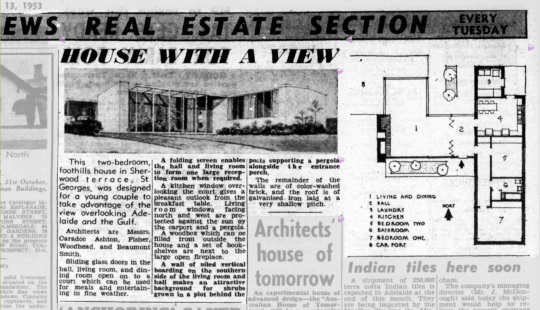
That same year the architects undertook a controversial job to build a bank in the city centre on an extremely narrow block. This city building was the first Australian city building to be constructed of the crystalline skyscraper type (a curtain-walled skyscraper of glass, ten storeys high and 64 metres long). The building – originally the State Savings Bank of South Australia and reported to resemble the UN Headquarters building in New York still stands today on Hindley St – with its concrete western wall, huge aqua glazed tile front and Mondrian-like coloured glass eastern panels.
Following on from this, our home was extended and a new “parents retreat wing” added, with a separate hallway, bedroom, living space and ensuite. This was quite a revolutionary concept for the mid-1950’s apparently. The owners have a news article reporting the extension and a photo from the street with their kids atop a horse, such was the semi-rural, quiet and undeveloped location.
The architects went on to larger and more prestigious projects. In 1957 they worked on part of the St Peters Girls school in Erindale, and the new Chrysler building at Tonsley Park which at the time lay claim to being the largest building under a single roof in Australia.
In 1958, the principal of the group (Caradoc Ashton) received an Order of the British Empire (OBE) at the Queen’s Birthday Honours in June in the UK for services to colonial architecture.
Subsequent to that the company completed numerous large projects in Adelaide – like a new wing of the St Andrews General Hospital on South Terrace in 1959, a 65 000 sq. ft. factory in Gepps Cross in 1959 and smaller commissions like a gorgeous glassed gentlemans residence for one in Stirling.

During the life and evolution of this project so we’ve found some incredible synchronisities and it continues to delight us with its simplicity and the integrity of its materials. Much of the continued life of this 60+ year old dwelling can be attributed to the vision and foresight of the original thinkers behind this home.
We hope we can maintain the standard set so long ago.
(Thanks to Dr Julie Collins at the University of Adelaide’s Architecture Museum at the School of Art, Architecture & Design for sourcing historical material)
http://www.unisa.edu.au/business-community/galleries-museums-and-centres/architecture-museum/
Yesterday – along with the Paris Climate Change conference starting and Christmas events and end of school year schedules, I made time to pause for the species we have lost.
Yesterday, November 30th was International Remembrance Day for Lost Species.
It has been phrased the “death of birth” – a term coined by a CEO-maverick-turned-sustainability-champion who once owned the US’s largest carpet company……Ray Andersen (May he rest in peace.)
His company Interface carpets is set to be the first company on earth to produce a zero negative-effect on the environment, a goal likely to be achieved by 2020.
Imagine if every CEO’s heart was moved by the prospect of the “death of birth”- that for hundreds of species there will be no celebration of new life from now into eternity. Such a loss breaks my heart.
The year I was born (1968) was the final year a baby White Lake cave crayfish was ever born in the USA. You can find out what species was lost the year you were born too by clicking here. This species was discovered and deemed extinct all in the same year I arrived on the planet (with 7 living in a single location in Alabama).
The species had a range of <1km square and were exquisitely formed for that environment. So many of our lost species have lived in incredibly intricate and interdependent ecosystems – such that a tiny shift of either human or natural influence could alter their state of being.
With a guilty heart we know though it’s hardly from natural causes.
Feral pigs and logging wiped out the Northern Gastric-brooding Frog in Australia in 1993. Only formally recorded in 1984, this crazy Queenslander, after hatching about 25 young at a time the parents would starve for 30-40 days while they matured in their mouth. At any one time they never strayed more than 4 metres from water. Many lived in the same pools in which they were born.
Imagine being the researcher to have to report back that the species had gone. No more babies. It’s astonishing that a plan was published as early as 1909 highlighting concerns for amphibian species (“National Recovery Plan for Stream Frogs of South-East Queensland”.)

In 1845 these magnificent Paradise Parrots were thought scarce and a campaign launched in 1918 for more research.
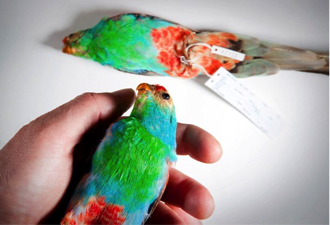
Attempts at captive breeding in 1927 were attempted – but by then it was too late. Almost nothing is known about them other than their sweet chicks hatched from pinkish-white eggs. Oh, and that they fed mostly on termites whilst on the ground. It is presumed feral cats wiped them out.
Another species which may have escaped death is the Lake Pedder Galaxias (Tasmania). With no scales but golden skin, large scale hydro-power flooding reduced their home to 2 creeks in 1990 with the last 4 fish found in 1996. Luckily, 11 fish were moved to a different location, survived and 74 eventually returned.

They are still in danger as researchers (who count the fish by snorkelling at night !) haven’t yet found any evidence of reproduction. It has taken 3 Federal level management plans to keep their genetic code in our planetary library.
The Mexicans lost a Grizzly Bear (1964), the Balinese a tiger (1937). I recall shedding tears for the Yangtze River Dolphin in 2002. Did you know Tasmania used to have it’s own emu? Oh, and Aboriginals too (but that’s a whole ‘nother story.)
Some websites listing animal extinction say that there are no recorded extinctions since 2012. Other suggest there is a loss of 3 per hour. I assume the discrepancy is because there is still such an incredible abundance of flora and fauna that we can’t comprehend, and we are still to discover. I can’t recall whether there are hundreds or thousands or even millions more species. Why don’t you find out?
But you might ask – why should I care?
We have such an immature understanding of ecosystems we can never be sure which species might (or might not) be expendable. My empathetic mammalian brain prompts me to suggest none are expendable.
“It’s as though the nations of the world decided to burn their libraries without bothering to see what is in them,” said University of Pennsylvania biologist Daniel Janzen.
Aside from their intrinsic right to exist – there is so much knowledge, so many solutions and even cures to be found from our natural partners.
The idea for velcro was stolen from a hooked seed design, the bullet train modelled from a kingfishers beak. Ingredients derived from plants form about 25% of the pharmaceutical chemicals we use today. There are 3 plant species (in Australia, Panama & Costa Rica) which are likely to hold the key to an AIDS cure. Jellyfish are thought to secrete natural sunscreen compounds.
Spare a thought for all those babies……..those hatchlings, seed pods, fluffy, furry & fragile things.
See below a sad list of our legacy in Australia. The site refers to our national anthem “our land abounds in nature’s gifts, of beauty rich and rare”.
May you poor things be resting in peace somewhere with Ray Andersen.
Lake Pedder Earthworm
Mountain Mist frog
Southern Gastric-brooding Frog
Northern Gastric-brooding Frog
Sharp-snouted Day Frog
Southern Day Frog
King Island Emu
Kangaroo Island Emu
White Gallinule
Paradise Parrot
Norfolk Island Kaka
Lord Howe Gerygone
White-chested White-eye
Robust White-eye
Tasman Starling
Thylacine
Pig-footed Bandicoot
Desert Bandicoot
Lesser Bilby
Desert Bettong
Nullarbor Dwarf Bettong
Desert Rat-kangaroo
Broad-faced Potoroo
Central Hare-wallaby
Eastern Hare-wallaby
Toolache Wallaby
Crescent Nailtail Wallaby
Dusky Flying-fox
Lord Howe Long-eared Bat
Christmas Island Pipistrelle
White-footed Rabbit-rat
Capricorn Rabbit-rat
Lesser Stick-nest Rat
Short-tailed Hopping-mouse
Long-tailed Hopping-mouse
Large-eared Hopping-mouse
Darling Downs Hopping-mouse
Broad-cheeked Hopping-mouse
Long-eared Mouse
Blue-grey Mouse
Gould’s Mouse
Bramble Cay Melomys
Maclear’s Rat
Bulldog Rat

Prior to looking for a house of our own in Adelaide, if I had to outline my knowledge of modernist architecture, I might have mumbled something about large windows, square design, perhaps referred to Danish furniture and that would be it.
Modernism & I have never been buddies (until now).
While looking for our house in Adelaide we stumbled onto a couple of ingeneous houses that piqued our interest in 1950’s & 1960’s house design. They are both located very close to the house we eventually bought (the suburb of Beaumont) and are perfectly suited to their locations.
The first one is designed by Harry Siedler – one of Australia’s major architectural heroes. The other a similar design is one which we walked through several times. The second (bright and simple house) opened up our eyes to Modernist architecture, especially since it was listed on an incredible site devoted to buildings of that era Modernist Australia, a go-to for all the nations modernist real estate news and sales.
Thus began a new infatuation with Modernism.
What is Mid-Century design, or Modernist ? Some of the major features are:
Using natures elements for energy use in the home – cross-ventilation for cooling & solar passive design. We knew our house was designed this way due to the crazy 45 degree angled way it sits on the block for maximum orientation.
Flat or single angled roofline (ours is flat).
Open plan living, that includes a sense continuity between the outside & inside, including large and/or floor to ceiling windows and abundant relaxed informal living areas.
Clean lines and lack of unnecessary decorative and ornate styling such as ceiling roses, iron lacework etc. The most we have is a bit of timber panelling & copper fireplace.
The use of industrial-style materials – in the case of our house we have factory sized steel beams in the retreat, lots of brick and natural surfaces like wood paneling.
In essence, the features of these houses are akin to a modern Australian sustainability check-list.
While these simple homes have experienced a resurgence in design circles, too many are still being demolished for bloated examples of faux-Victorian or Neo-Asian boxes.
What is delightful is that with these homes that outside connectivity is always a high priority. Decks & terraces feature, in addition to thoughtful light positioning. Designs are typically “crafted” – architects used craftsmen to complete details, gave strong attention to detail and were constructed from durable higher end materials like brick, timber and glass as mentioned.
Ultimately designs were primarily to create a positive human dwelling, with only what is necessary and nothing extra. Really, nothing wasted. Simple, just like environmental responsibility.
What we are still marvelling at is how private, spacious and solid our home is. We have been converted to Modernism. Can’t wait to convert this thing into a 2015 sustainable marvel. The architects would be pleased.
In order to find the right house for us to buy as a family, we had took a look at some interesting places. We spent many, many weekends looking at homes that hadn’t been renovated for 40 years or more, people who built, married, grew families & died in the same place.
There are dozens of 1935-1970’s aged houses going under the demolishers ball here in Adelaide.
This photo blog is a little view into some of those properties. They are not all great photos, as some had to be surreptitiously taken one room ahead of the estate agents walk-through.
Most of these houses no longer exist.
I’d like to see a return of the sewing room……………………
- Here’s to the “painted every decade” back lean-to. And the light fittings that are indestructible.
- To home-decoration, not shop-bought. I wonder how the recently-cool macrame lovers would view this one?
- The world needs to have more hand-door bells. No electricity required. Please ring.
- To breakfast bars, bamboo and built-to-last.
- C’mon wall paper designers, can we have a return of these?
- I had never seen a wooden wheelbarrow before this one – and it’s likely I never will again.
- Hand embroidery in the sewing room. Vive la sewing room !
- Best map ‘oTassie I think I’ve ever seen !
- To the door that still works, the original lock, and the key that was lost decades ago. That no key cutters ever going to re-create.
- When greenhouses were for plants, not food. And they weren’t supposed to be pretty. They were for the plants, not our views.
- Ode to the ugly back shed.
- Here’s a cheer to low fences and those juicy bricks. Wonder if anyone makes them anymore?
- Cos’ the kids height was more important than pristine white.
I wish I knew where I saw it written. Am pretty sure it was in a newspaper, a real estate lift-out guide perhaps.
It said before you buy, you need to have looked at 50 houses, to determine the kind of structure you are looking for, its relative cost when compared to surround suburbs to be able to narrow down the actual value – ensuring it is as close as possible to your budget.
Yep, that’s what I read. I wouldn’t make something like that up.
So we did. We looked at 50 houses – not in the paper – in the flesh ! Oh dear, what process. I had no idea how competitive cities are, how many bad houses are out there, how awful some people’s choices are, and how desperately you can long for one particular perfect house, miss out on it at auction and never look back. It ended up taking 8 months to buy our house and 90% of our weekends included house inspections.
In the end, we didn’t buy a bouncy-castle house. They might look fun from the outside, but once inside it’s easy to be deflated. Bouncy castle houses are fun & attention-grabbing but without substance. Instead, we learnt lots about styles and features (mostly what we didn’t want) which was a very important part of the exercise as it helped define what we wanted in a sea of choice.
Here’s a smattering of houses we bid on at auction or made offers for.
Some observations about property to avoid in Adelaide include:
1) The villa vacuum
We saw lots of lovely Victorian villas (from the front). They are such a feature of this city that no doubt someone reading this will have one and be offended. We LOVED them so – at first. But like a bouncy castle, they were all show without substance. Made of stone (cold) and only 4 bedrooms really with an extension you’d have to rip off and start again with. For $900 000 ! I know ! It’s crazy ! We are renting one and it’s cracked, cold in winter and hot in summer. That Adelaidians love their old homes is admirable – from a materials sustainability perspective. But unless you’re on the north side of the street, they are wrong. Dark, damp – and still trendy. And a maintenance money pit. Absolutely lovely to look at from the streetscape – but how these are as desirable as they are I don’t know.
2) The Lego
We saw quite a few of these. Like Lego, you just keep adding & adding. Then it falls over. There’s simply nothing you can do to fix this house. Money has been thrown at it, to get sunny vistas, to get extra bedrooms, another bathroom, etc. The problem is the house design was poor to begin with. The Californian bungalows with the living areas smack bang in the middle of the house are one kind. The afterthought teen bedroom jutting out into the backyard. Materials that weren’t great to begin with, then additions that are worse. Oh my.
3) The dark side of the street
Despite having all the features we needed, there were 4 houses we liked initially but then we went inside. The bedrooms all faced the sunny side of the street and the main living spaces were in shade. The idea that a building can be built without sunny outdoor space still seems lost on people. It didn’t take us too long to immediately rule out any house that wasn’t orientated correctly, no matter looks or price or convenience.
I would definitely recommend spending as much time looking as you possibly can when buying a house. Give it a year, double the size of the area you’re looking to buy in, make up wish lists of features you want (old vs new, single vs. double storey, street type, streetscape, diversity of building styles and sizes, access to transport, slope, orientation, materials, architectural style) and be relentless in your pursuit of what’s smart over what seems beautiful. Cos’ in the end good liveability IS the most beautiful quality of a home.
We were looking for our dream home.
Our family had a fairly simple wish-list.
It included a wide street for road hockey, timber floorboards perhaps, large windows and maybe a fireplace. Lists were drawn up by all members of the family. A new house (daughters wish) was ruled out as we didn’t think we had time to build from scratch and it appeared there was a distinct lack of land for sale in the areas we wished to live. Sufficient space was important.
But it didn’t take long before the phrase “dream home” stopped resonating. For us it sounded shallow and overly consumeristic. Dream homes imply BIG homes – that you’ve thrown every penny you have at them. And much of the conversation we were having ended with “for re-sale”. So then it sounded like what we were possibly going to live in was OUR interpretation of SOMEONE ELSE’S dream, which doesn’t make sense.
Australians now have the world’s largest houses. Our dwellings are on average 243 square metres in size (our is a wee bit bigger at 252m sq). That’s 10% larger than our US counterparts ! Winning this global race is nothing to be proud of – it has forced our young people out of ever even entering the housing market. Surveying their expectations about home ownership shows a rapid downward slide since the 1980’s.
As our house meterage increases, we are also adding pools and outdoor rooms and a number of more complex gadgets. Our ceilings are stretching upwards, and our furniture outwards. Between 1984 and 2003, our house size jumped by an incredible 40%.
In addition to that – we are only living in our dream homes for an average of 9 years !
Pretty brief dream.
So we stopped talking about a dream home. It’s not what we want. Out of interest, I thought I’d take a look at what other people thought “dream home” meant.

Here’s a classic North American style “dream home” image from the internet. There were hundreds of them to choose from. Note the great height, massive walls, balconies, porches, manicured lawns, spa & pool. Am guessing a family house, up to 5 people living here?
As a long-time environmentalist these images gave me the horrors. How to re-word what we were looking for ?
I tried “sustainable dream home”……..

Here’s a totally different kind of image. This is what you get when you add “sustainable” to the front of “dream home”.
The first thing these houses have in common is surroundings. The photos are all of houses situated in lovely places. The “sustainable dream home” images are largely of gardens and windows. They are lower to ground, much, much smaller and frankly, you can’t see anywhere nearly the same amount of house.
I thought about the notion of place and of dwellings and around this time went to an Aboriginal women’s night. I was super inspired at how when each woman introduced themselves they said “I am so & so, my father is from such & such tribe which is located in this place, my mother is from this tribe whose country spans this area.”
It made me think about the term Australian Aborigines use. The term “dreaming”. For them this phrase means the interplay between the daily world they inhabit, AND the other world of spirituality, morality & nature. Their dreaming is a guide book for their lives. There is no soporific state, no hazy, uninformed quality to their dreaming. It seemed to me I could draw parallels between our dream home and the qualities of indigenous beliefs.
I decided then that we should say this is our “dreaming” house.
Indigenous people see themselves as part of nature, and likewise the ecosystems around them having human qualities. Their stories, art and culture are interwoven with this link. Stories are told about ancient times where reptiles show empathy, or plants can lash out in anger. This deep spiritual connection to land goes beyond our understanding of “dreaming”.
With this context firmly tucked into our back pocket we looked further at houses for sale – looked more into the outskirts and the bush fringes of Adelaide. For me it seems that part of our disconnect with our external ecosystems & the way we treat the planet is a direct result of being too comfortable in our homes, cut off from light and weather, sounds and creatures. To be connected with the outdoors invites reflection, surprise, air quality, food sources, natural aromas and the constant change of clouds and movement. Aboriginal dreaming stories are all about this.
The next few blogs will trace the process as we search for our dreaming dwelling – that also happens to be our home.
And we’ll be there more than 9 years for sure.
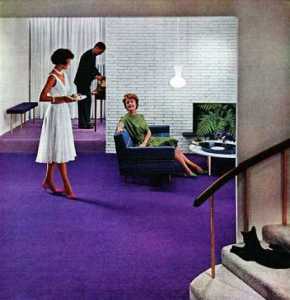
The 1960’s were the hey-day of carpet. This colourful, noise reducing, imperfection-hiding, low-maintenance, comfort and slip-resistant floor covering surpassed all. It was a wall-to-wall whole-house flooring extravaganza. Our new (old) house was no exception there was plenty of it in all rooms except for wet areas and the kitchen.
It was a sad day for our Modernist sustainable renovation efforts last year when the first job we had to do was remove carpet – knowing it is likely to be the single largest (by volume) waste that we’ll be contributing to landfill during this project.
We pulled up some mighty fine 40-year old loop pile, some Cavalier Bremworth woollen broadloom (sounds like a fine scotch) and then wondered what to do with it – we called around, read, stalled…..and sighed.

According to the Carpet Institute of Australia (formed in purple-tufted 1967) the local industry is still healthy, with national sales of around $1.6 billion per year. An increasing percentage is imported sadly, however the bulk of consumption (80%) is manufactured in Melbourne, employing around 3,300 workers.
Carpet manufacture is the largest single component of the Australian textiles manufacturing industry. And good news too for SA as there is an Adelaide based carpet company – the EC Group, recently highlighted in the Adelaide Review as “punching well above it’s weight”.
The bummer about carpet though is it’s end-of-life treatment.
In 2011, approximately 56 million square metres of carpet was laid. Once it reaches it’s end-of-life 80% of that carpet will go directly to landfill. That’s a major contribution to our dumps. The renovator in me rages at the knowledge that we are contributing to this landfill waste. What we don’t hear enough of in green circles is that 30-40% of landfill waste comes from building sites.
The US has an incredible carpet recycling industry. CARE (Carpet American Recovery Effort) have managed in just over a decade to recycle over 3 billion pounds of carpet – pointing out that “successful waste carpet recycling begins at the point of collection”. To date there’s no financial, innovation or ethical driver to do that here at any scale.
There are other options – but there is only so much you can do with scrap carpet (see here 10 uses for carpet scraps) and what if every house has enough scrap carpet for 100 houses? Although carpets and rugs are made of recyclable fibres such as wool, nylon and polypropylene there are NO commercial recycling facilities in the country that take carpet from any source.
An alternative, innovative manufacturing opportunity right there South Australia…..
Until such options become available, the options are ;
1) Try to sell or give away to carpet second supplies or salvage or Habitat-for-Humanity charity stores,
2) Give away to anyone willing to collect
3) Then disposal options as a last resort.
(That’s about as disappointing as this colour scheme).

There are some positive steps being taken by a select few if you do your research.
Three companies Ontera, Godfrey Hirst and Cavalier Bremworth have recycling mechanisms for their own products. you are purchasing carpet, favour these innovators…..
Cavalier Bremworth 100% wool product (bought for commercial scale projects) may be returned when replacing the flooring with new product. The returned biodegradable wool and rubber carpet is recycled into weed-matting at the end of its life (over 30 000 mats have been given to school and council revegetation projects with research apparently showing no toxic compound run-off).
Even better, Godfrey Hirst will take their own commercial product back to be re-manufacturered in Geelong as backing for their own new carpets.
Ontera takes it own product back and to date 600 tonnes have been super cleaned and refreshed with a new design surface. They say their tiles may have one or even two new lives. Called Earthplus, the company has calculated that for every 1000 sq. metres of carpet saved, 5 tonnes of materials are saved in new carpet manufacture.
When purchasing new carpet, consider that generally speaking synthetic polymers will remain in landfill for significantly longer than natural fibres (such as wool and jute). Woollen carpets are likely to biodegrade in less than ten years. Another reason to purchase wool – approximately 90% of second hand commercial carpet is wool. Carpets and carpet tiles selected by architects on major projects from commercial sites can be sought for a fraction of the original price.
On the flip side once an industry for recycling is established, some synthetic products like nylon are the preferred option, as they are the most highly durable material for a second life.
McMats Recycled Carpet is a final option. For 18 years they have been diverting commercial floor coverings from landfill in Melbourne. They collect commercial carpets, whose previous owners can afford the simple steps that make domestic collection so difficult. At a domestic scale carpet is highly contaminated with stains, timber & tacks. With large expanses of flooring, the product has fewer contaminants, they can roll and load yarn side out and transport directly to the recycler. That’s all it takes.
Contamination is the main reason why we don’t recycle. Oh, and collection is complicated.
It’s difficult. That’s it. If we handled it as carefully as we did coming into a house, this problem could be solved. So simple. So frustrating.
There’s no real way to end this post. So I’ll just sweep the crumbs into a corner…….
It’s a little hard after watching Project Wild Thing film not to be enthused about the outdoors !
David Bond’s longing for his kids, nay, all of society to play, to be well & be fully connected with our ecosystem is so palpable. He’s so earnest, so spot on. We don’t need more iPads. We just need to roam in the green and the gritty.
And there’s good reason to be so earnest, as nature-deficit disorder is such a profound, hidden problem of our time. But I won’t go into that now (if you want more you can read my post on “nurtural parenting” here)…….
As a result of watching the film, my teens spent a few good hours out in the street. They climbed dozens of jacaranda trees. It evolved into a major tree-climbing-crawl all up & down the street.
An amazing conversation evolved about what defines “climbing”. Does hanging count? Even if it’s close to the ground? Is it based on risk, or falling potential? Does it have to constitute a certain height? Do the feet have to touch the tree, is hanging included?
What transpired I thought was quite glorious. They defined the action, the moment of having climbed a tree as any time you sense you’re far enough removed from the ground that it “feels like you’ve escaped gravity”. Not a distance, not the likelihood of falling. Harm didn’t enter their mind. In fact climbing can be achieved by not being very high up at all and it CAN involve hanging (well, according to my kids). So we did an experiment – and independently they both agreed on certain states of being in a tree that were definitely climbing and certain ways of being in a tree that definitely weren’t……it was truly fascinating…….
It was a feeling. An innate feeling. Thinking back to my own childhood, I think I can recall exactly what they meant. It might have to do with the fact that for thousands of years, climbing trees was a way to save ourselves from predators. It might be that possibly millions of instances of past memories are embedded in our DNA. That this memory, this intuitive wisdom has been passed down from thousands of surviving ancestors, for whom without their “abili-trees” (kids pun) we would not be here.
So with the kids way ahead of me in this dialogue – they came up with the idea that you could claim a tree, put your stamp on being able to have climbed up a certain one – and it always elicits a sense of pride & dominance.
It was climbED!
And with that, coupled with some final sparks of childhood imagination (they are 12 & 15, so there’s not much left) they conjured up the idea that a flag, a mark of triumph over a tree meant you’d slayed the dragons, overcome a potential threat, defeated an imaginary ground-hugging enemy.
Climbing in their minds suddenly assumed much greater importance. “WE SHOULD TELL EVERYONE ABOUT IT !” (This came from the 15 year old).
Hence we came up with the banner. A biodegradable flag, made by the climber, with sticks collected from the trees would be an appropriate badge of honour, a public (but anonymous) reminder that we can still defeat predators, we still have little remnants of wild in us and that it’s an inherited characteristic to be proud of.
I have no idea where this project will go, but wouldn’t it be incredible to see physical expressions of childhood joy, evidence of the still-wild billowing & swinging from trees beside highways, along polished heritage avenues, high up, shouting out to us… “be free, there’s still time !”
I might just do a few myself.
Please let me know if this idea resonates with you and where/how we can take it further……
Hooray, it’s a legitimate shopping day !
I was going to a meeting this day and my trousers were just too big. I really needed a belt. I already thought about it & decided to buy a second hand belt. This doesn’t constitute a breach of Buy Nothing Month since, a) It’s an essential. I only own 3 belts, all of them second hand. I needed a black one, a professional one, and b) It wasn’t “NEW”.
Ten bucks. Lovely quality black leather. Minimalist silver buckle. Made in Italy. Salvation Army you rock !
In celebration I also bought a $4 glass toothbrush travel vial. It’s positively glamorous. We are on holidays soon, so am planning to pack light, green and plastic-free as I try to do with most things.
Day considered a success. No more purchases made that day.
Wow, I’ve found my consumption Achilles heel. Feeling a sense of scarcity, rather than abundance.
First it was a feeling of inadequacy about the fact we don’t own our own home (result = house magazine), second it was feeling guilt and towards how we have treated our indigenous brothers & sisters (result = unnecessary postcards) and today it was because I haven’t got a garden (result = veggie seeds).
Man, if I had a veggie garden even half the size of size of my last one, none of these buying slip-ups would occur! I’d be too busy messily pottering around in the dirt!
So I bought seeds. I bought veggie seeds cos’ I’d spent hours in the city running errands and it was a glorious day & I was yearning to be in a large green space. I didn’t need the seeds, but it’s spring & stuff grows in spring & it’s what all the other veggie gardeners are doing. But I am not.
Sure, I’ve got a couple of pots of mint, lemongrass and parsley – but it’s hardly a garden, it’s someone else’s garden and there’s nowhere to make one.
Buying the seeds made me feel better. And in the next couple of seasons I will plant them. They won’t go to waste.
They were organic. They were heirloom. They were bought at the local markets, the packets made from compostable card.
So there.





